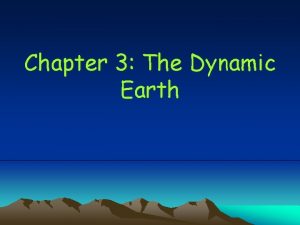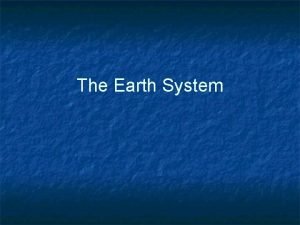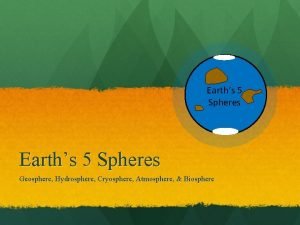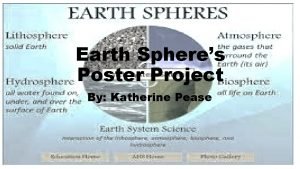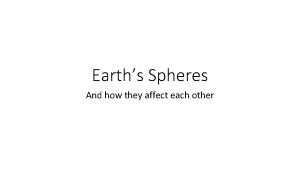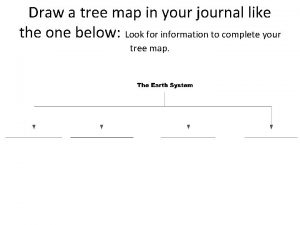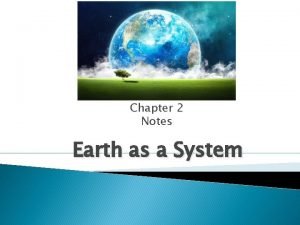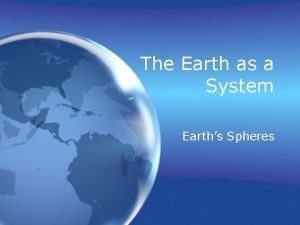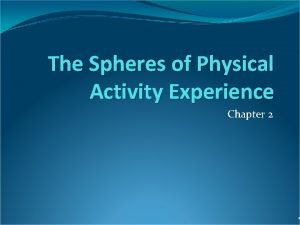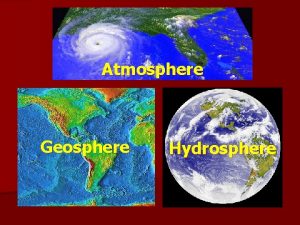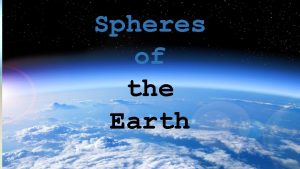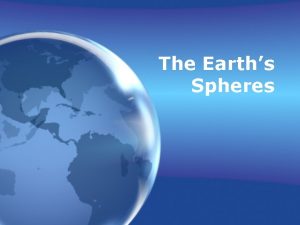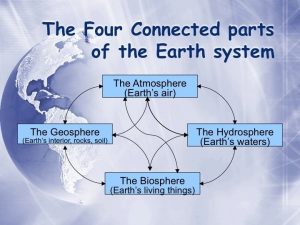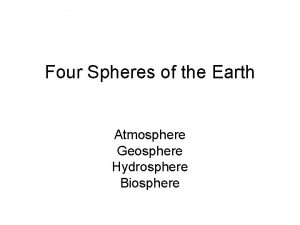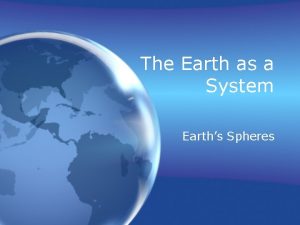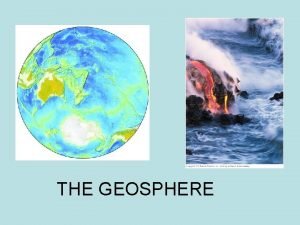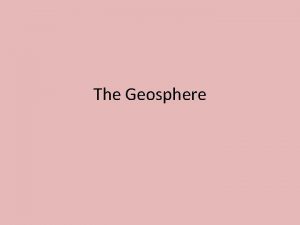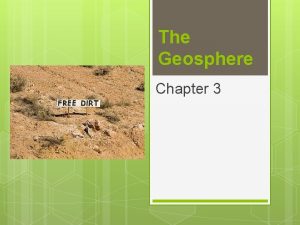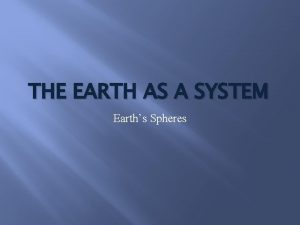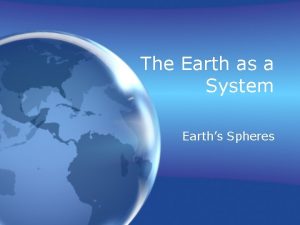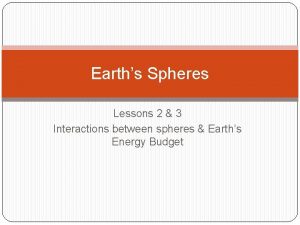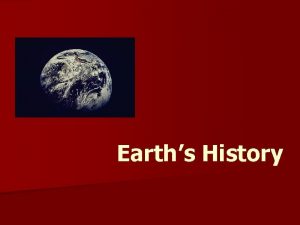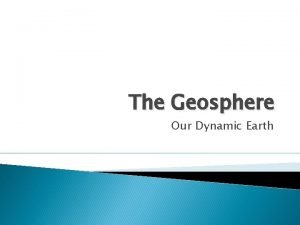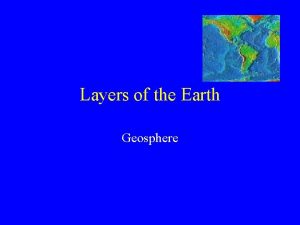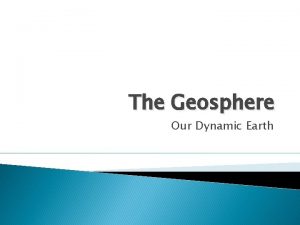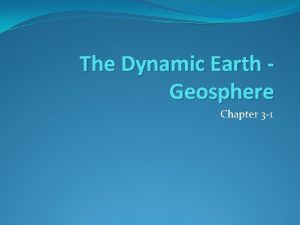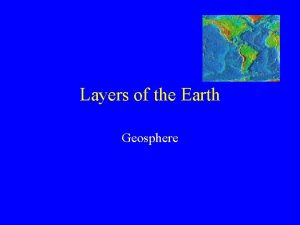Earths Spheres 4 spheres 1 Geosphere physical Earth


























- Slides: 26

Earth’s Spheres • 4 spheres – 1. Geosphere – physical Earth • Sometimes called lithosphere (outer crust) – 2. Atmosphere – blanket of gas surrounding the planet – 3. Hydrosphere – All of Earth’s water – 4. Biosphere – all living things

Our Place in the Solar System • 3 rd Planet from the Sun • We have seasons due to our tilt and revolution around the Sun


Earth’s History • How old is Earth believed to be? – 4. 6 billion years old • What are some of the most significant events in Earth’s history? – ~3. 5 billion years ago – first cells formed – 2 bya – Oxygen Revolution – 1. 8 bya – first eukaryotic cells appeared

Other significant events: • Paleozoic Era: – Carboniferous period – current coal and oil deposits went into ground to begin forming (325 mya) – Life transitions from sea to land

• Mesozoic Era: – Reptiles dominate and mammals arose • Cenozoic Era: – Mammals began to thrive

Agricultural Revolution • 10, 000 -12, 000 years ago • Domestication of plants and animals – Nomads communities

Industrial Revolution • 18 th-19 th centuries • Movement from renewable energy to nonrenewable energy – Prior to IR, biomass fuels (wood) most common

Feedback Loops • Positive feedback – Runaway cycle in one direction • Negative feedback – System keeps itself in check

Synergy • The sum of two parts is greater than the two individually

Time Delays • Any sort of event that takes a long time for a response or action to occur

Laws of Thermodynamics • First Law of Thermodynamics – Energy is not created or destroyed, just changed. - Input = output

2 nd Law of Thermodynamics • Energy transfer is never 100% efficient – some will be lost to environment as heat – An incandescent light bulb gives off about 95% of the energy used to power it as heat



Biomass • Anything within the ecosystem considered a fuel resource • Also the dry mass of organisms in the ecosystem

Ecological Pyramids • Pyramid of Numbers – shows population of each level in a food chain

Pyramid of Biomass • Shows the amount of biomass (dry weight of organisms) present at each trophic level in a food chain

Pyramid of Energy • Drawn to show energy utilized at each trophic level

PRODUCTIVITY OF ECOSYSTEMS • Gross Primary Productivity (GPP) –Rate at which an producers capture and store chemical energy as biomass in a given time period • Net Primary Productivity (NPP) – The rate at which primary producers accumulate net useful chemical energy – NPP = (Rate at which producers store chemical energy as biomass) – (Rate at which producers use some energy for respiration) – NPP = GPP – Plant respiration

Productive Ecosystems • Two most productive ecosystems on Earth: – Wetlands – Rain forests • Least productive: – The ocean (as a whole) – Deserts

Biogeochemical Cycles Type of Cycle Water Carbon Phosphorous Sulfur Nitrogen Major Storage Area In the oceans Dissolved into the oceans In Earth’s crust as rock In Earth’s crust within rocks and minerals In the atmosphere

Nitrogen Cycle – *MUST KNOW* • First Step: NITROGEN FIXATION: Bacteria (cyanobacteria (soil and H 2 O) and Rhizobium (roots)) convert gaseous nitrogen to ammonia that can be used by plants. – N 2 + 3 H 2 -> 2 NH 3 • Nitrogen can also be fixed through lightning – 3 N 2 + 6 H 2 O -> 4 NH 3 + 2 NO 3

• Second Step: NITRIFICATION: • Ammonia is converted by Nitrosomonas to nitrite ions – 2 NH 3 + 3 O 2 -> 2 NO 2 + 2 H+ + 2 H 2 O • Nitrobacter convert nitrite to nitrate ions, which are easily taken up by plants as a nutrient. – 2 NO 2 - + O 2 -> 2 NO 3 -

• Third Step: ASSIMILATION – plant roots absorb nitrites, ammonium, and nitrates needed for growth. • Fourth Step: AMMONIFICATION – Specialized decomposer bacteria convert animal wastes and dead organisms into ammonium

• Fifth Step: DENITRIFICATION: Bacteria (Pseudomonas) convert nitrates back into nitrogen gas
 Earths 4 spheres
Earths 4 spheres Chapter 3 the dynamic earth section 1 the geosphere
Chapter 3 the dynamic earth section 1 the geosphere Study of the earth's physical features
Study of the earth's physical features What are the four spheres of the earth
What are the four spheres of the earth Four spheres of the earth
Four spheres of the earth 5 spheres of earth
5 spheres of earth Earth's spheres foldable
Earth's spheres foldable Spheres of the earth poster
Spheres of the earth poster Sphere interactions examples
Sphere interactions examples What are the four spheres of the earth
What are the four spheres of the earth Earth's spheres
Earth's spheres Hydrosphere drawing
Hydrosphere drawing Earth's spheres foldable
Earth's spheres foldable Geosphere atmosphere hydrosphere and biosphere
Geosphere atmosphere hydrosphere and biosphere Spheres of the earth
Spheres of the earth Sphere of self sufficiency
Sphere of self sufficiency Spheres of physical activity
Spheres of physical activity Earth layers foldable
Earth layers foldable Earths roation
Earths roation Whats a natural satellite
Whats a natural satellite Biome near the equator
Biome near the equator What is the most abundant element on earth
What is the most abundant element on earth Basalt
Basalt Whats earths moon called
Whats earths moon called Earth's thickest layer
Earth's thickest layer Earths early atmosphere contained
Earths early atmosphere contained The earths layer foldable
The earths layer foldable

